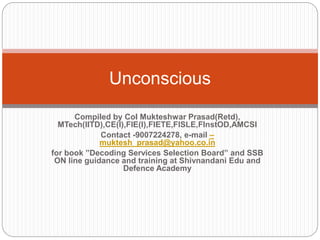
Unconscious.pptx
- 1. Compiled by Col Mukteshwar Prasad(Retd), MTech(IITD),CE(I),FIE(I),FIETE,FISLE,FInstOD,AMCSI Contact -9007224278, e-mail – muktesh_prasad@yahoo.co.in for book ”Decoding Services Selection Board” and SSB ON line guidance and training at Shivnandani Edu and Defence Academy Unconscious
- 2. Sigmund Freud According to psychoanalysts, much of behavior is caused by parts of personality which are found in the unconscious and of which we are unaware. Freud’s 3 levels of awareness/consciousness: The conscious mind; The preconscious mind; and The unconscious mind.
- 3. Psychoanalysis: The Unconscious “the mind is like an iceberg - mostly hidden” Conscious Awareness small part above surface (Preconscious) Unconscious below the surface (thoughts, feelings, wishes, memories) Repression Banishing unacceptable thoughts and passions to unconscious: Dreams and Slips
- 4. How do the views of the neo-Freudians differ from those of Freud? In Jung’s theory, the personality has three parts Ego Personal unconscious Collective unconscious Jung rejected Freud’s ideas that the sexual instinct is the most important determinant of personality that personality is mostly formed in childhood Copyright © 2008 Allyn & Bacon
- 5. Unconscious The conscious mind contains all the thoughts, feelings, cognitions, and memories we acknowledge Consciousness requires attention, but information can register in the absence of directed attention. Unconscious consists of deeper mental processes not readily available to the conscious mind. The unconscious is the repository of automatic skills, the source of stored memories, fantasy, and dreams. Is the vast sum of operations of the mind that take place below the level of conscious awareness. Much learning takes place outside of conscious awareness (especially recognition of complex patterns). Many of the elements that go into judgments and decision-making are processed outside of awareness. Intuition (a set of assumptions swiftly assembled from cumulative knowledge and experience.)is a product of unconscious mental operations, Much of human motivation and interpersonal attraction also take shape beyond conscious awareness. Why do we even have an unconscious? The brain is a very busy organ, running the body, constantly taking information in through the senses, making decisions—all at the same time. The unconscious is an engine of information processing, and most human functioning takes place in it
- 6. How the Unconscious Mind Works Unconscious mind does the lion’s share of the brain’s work Information is stored associatively in the brain, which is bundles of pathways of association —far too many to remember, but usually responsive to activation when needed. What behaviors come from the unconscious? People automatically tend to imitate The physical behavior of others Also their emotional displays These are response generated unconsciously( an important contributor to the ancestral human need for social cohesion. ) Much research shows that feelings arise in the unconscious, as everyday events stimulate networks of associations, and while we may be aware of the feelings, we often do not know how they arose. Is the unconscious smarter than the conscious mind? The unconscious mind processes information faster than the conscious mind, and intuition . But it is neither smarter nor stupider than the conscious mind. It is an essential part of our normal mental operations, as most human behavior is a mixed product of both conscious and unconscious brain
- 7. Conclusion Will my unconscious make me do or say self-destructive things? The unconscious mind evolved as a way to help us survive , sometimes referred to as the “shadows of the mind,” because it was thought to be a shadow of the “real” mind Although it is not a black hole (or bent on destruction)of unacceptable impulses Can be a source of hidden beliefs, biases—so-called implicit bias—fears, and attitudes that affect everyday thinking and behavior. Hence most forms of psychotherapy aim to bring into conscious awareness hidden beliefs and fears, often acquired during childhood so that they can be critically examined and their current value determined. What sorts of problems can be fixed by working with the unconscious? Unconscious beliefs and feelings can be a hidden source of distress, leading to such common problems as self-defeating thoughts, anger, spending sprees and many forms of compulsive behavior in individuals. The same sources of distress can also set off painful patterns of interactions between partners in a relationship and members of a family, which often show up as behavior problems in a child.
